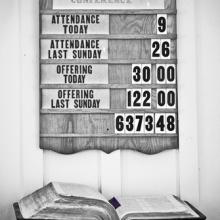church attendance
I recently had a conversation with a woman who used to be a church-goer when she was young, but hasn't found herself in a church setting in a while. When I told her I lead worship at a nearby church, she was interested in coming to visit. We in the church have theories about where we go wrong in bringing new faces into our buildings. Out in the world people go about their everyday lives, and we watch to see if they are a part of the church or outside of it.

Image via Leadership Network / RNS
Change is coming to American megachurches — those behemoths for believers that now dot the religious landscape.
There are more participants in megachurch worship than ever.
“Last weekend 1 in 10 adults and children who went to a Protestant church went to a megachurch — about 5 million people,” said Warren Bird, director of research for Leadership Network and co-author of a megachurch study released Dec. 2.
But individual attendance is down to once or twice a month — or less.
More Utahns go to church every week — 51 percent — than any other state, according to a new Gallup poll.
That statistic is “a direct result of (Utah)’s 59 percent Mormon population,” Gallup’s Frank Newport writes, “as Mormons have the highest religious service attendance of any major religious group in the U.S.”
The next most-frequent church attendees are in the South — Mississippi (47 percent), Alabama (46 percent), Louisiana (46 percent), and Arkansas (45 percent). In fact, 10 of the top 12 churchgoing states are in the South.
At the bottom of the list is Vermont, Gallup reports, “where 17 percent of residents say they attend religious services every week,” Newport writes. Just ahead of the Green Mountain State are New Hampshire (20 percent), Maine (20 percent), Massachusetts (22 percent), Washington (24 percent), and Oregon (24 percent). Half the bottom 10 are in New England.
A lot has been written about the decline of the mainline church over the years. Numerous theories have been passed around. Nearly every pew-sitting faithful Christian in America has her or his own opinion. As a minister I have heard a lot of these complaints from the masses; the request is simple. They want the church to be the center of social and political life as it seemed to be in the 1950s and 1960s. They want the pews packed with people, the nursery overflowing with babies, and the church to have the same level of particularity that it did years ago. The church today finds itself having to share time and attention with the rest of the world. Because of this (and numerous other factors), the church for the most part has seen the number of people attending the hallowed halls of a church house begin to decrease.
In an effort to find a culprit for the shrinking size and popularity of church, a scapegoat has been named and they are "young people today” — a catchall term for people under the age of 35 (or thereabouts) who have seemingly left the church en masse.
They are vilified as the sole reason and cause for the church to not be busting at the seams with people. If only those "young people" could just stop being so selfish on Sunday mornings and just come to worship God at 11 a.m. like people have been doing for years, the world might be a better place.
At a church I used to serve there was a well-intentioned person who after every service would tell me how many people were in attendance. “We had 47 today, Preacher,” he would say. I could hear the disappointment in his voice when he would have to tell me a low number like 35. A smile beamed across his face when we had more than 50. No matter the number, he would tell me without fail.
In every church that I have ever visited or served there has been an emphasis on the number of people that attend the morning worship services.
After years in the ministry, I have come to the conclusion that the church needs to stop taking attendance — immediately.
For many churches the process of collecting attendance is to get an accurate account of people in worship, to measure how many people occupy space in a pew. Some churches have notepads in the pews so people can fill out their information and place it in a designated area. Others have a volunteer to manually count the people in attendance. No matter how small or big the faith community is, an attendance is taken. Some congregations publish the number of people in their church bulletins or have it on a sign in the sanctuary to compare last week to this week.
For too long churches have measured their ‘success’ and ‘failures’ on the number of people that darken the door on 11 a.m. on Sunday morning. The quickest way to get people to wring their hands in worry is to tell them that numbers in worship have dropped. Visions of the church closing its doors will run through people’s minds inciting more and more anxiety.
It’s no secret that the church in the American culture is not where most Christians would like it to be. The church that was once the central hub of the community is now a place where a subset of people goes on Sunday mornings. The church has been in a decline for some time, and I believe this has caused us to become more inward focused. As the church began to experience decline numerically, the church’s reaction was to try making everyone left happy — from the ministers and worship leaders to the custodial staff. The boat was not rocked, things stayed the same, a course was laid, and no deviation would be acceptable.
“I know what you did last Sunday,” claims the title of a new survey.
That’s according to a new survey by the Public Religion Research Institute released Saturday. The study, to be presented at the national meeting of the American Association for Public Opinion Research, was designed to measure the “social desirability bias in self-reported religious behavior.”
The survey finds that many Christians — and unbelievers, too — will exaggerate about attending worship in live phone interviews. However, when asked in an anonymous online questionnaire, people will answer more realistically.
The go-to number in American religion is “ASA” — average Sunday attendance. Or as an irreverent colleague put it, “Fannies in the pews.”
It’s a meaningless metric, but it’s easy. Open the doors on Sunday, wait for the stragglers, then dispatch ushers to count the house.
Entire methodologies for church development have been built around this number, as if fanny count dictated how a church should behave. Problem is, ASA isn’t a useful measure of quantity, and it says nothing about quality.
A much better quantitative measure would get at “touches,” that is, how many lives are being touched by contact with the faith community in its various Sunday, weekday, off-site and online ministries — and then, for a qualitative measure, asking how those lives are being transformed.
Those are difficult metrics to track, of course, and that’s why many congregations stick to ASA and shun the harder work of measuring outcomes and impact.
This is a touchy subject for me, as I am a strong advocate of bringing cultural criticism and dialogue into the church, and I’m equally supportive of churches having frank forums where they deal with issues of sex and sexuality. But there is a distinct, if not fine, line between stretching a church to be relevant and jumping on the latest trend simply to draw attention to yourself.
Yes, I know religious institutions are collectively flipping out about the decreasing number of attendees and increased number of church closures. The fact is that some churches will do the world more good once closed than they’re doing today. This is not to say they’re doing active harm (though I’m sure some are), but rather that the tireless, copious use of resources – both human and financial – to prop up dying institutions is to point to one’s self rather than toward God. We get hung up on the idea that the former is a necessary means to the latter end, but not necessarily. Like a fallow field, sometimes it’s best to take what is left, turn it into the ground and allow it to be reborn into something entirely new.
To start, a story.
A few years ago a female student wanted to visit with me about some difficulties she was having, mainly with her family life. As is my practice, we walked around campus as we talked.
After talking for some time about her family situation we turned to other areas of her life. When she reached spiritual matters we had the following exchange:
"I need to spend more time working on my relationship with God."
I responded, "Why would you want to do that?"
Startled she says, "What do you mean?"
"Well, why would you want to spend any time at all on working on your relationship with God?"
Quit hitting the snooze button.
It’s time for the church to wake up!
According to a Laura Sessions Stepp at CNN.com, evangelical churches are finally acknowledging a trend that statisticians have been tracking for years: young evangelicals are leaving the church in droves.
In the new report, You Lost Me: Why Young Christians Are Leaving Church and Rethinking Faith, Barna Group President David Kinnaman notes a 43 percent drop in Christian church attendance between the teen and early adult years.
Perhaps most intriguing is that research indicates younger people are not only departing from their elders on “social issues,” such as same-sex marriage and abortion, but on wealth distribution and care for the environment, as well.
According to a report in The Christian Science Monitor, three out of four millennials say that wealthy corporations and financiers have too much power and that taxes should be raised on the very wealthy. Two out of three say financial institutions should be regulated more closely.
While the issue of jobs and higher wages remain as important to millennials as they do to older voters, the widening “black hole” of church attendance in the 18-29 age demographic indicates a larger trend — young people are thirsting for social justice, and simply not finding those principles in the pews.







